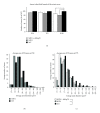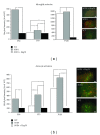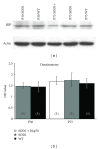Administration of Recombinant Heat Shock Protein 70 Delays Peripheral Muscle Denervation in the SOD1(G93A) Mouse Model of Amyotrophic Lateral Sclerosis
- PMID: 22900172
- PMCID: PMC3415202
- DOI: 10.1155/2012/170426
Administration of Recombinant Heat Shock Protein 70 Delays Peripheral Muscle Denervation in the SOD1(G93A) Mouse Model of Amyotrophic Lateral Sclerosis
Abstract
A prominent clinical feature of ALS is muscle weakness due to dysfunction, denervation and degeneration of motoneurons (MNs). While MN degeneration is a late stage event in the ALS mouse model, muscle denervation occurs significantly earlier in the disease. Strategies to prevent this early denervation may improve quality of life by maintaining muscle control and slowing disease progression. The precise cause of MN dysfunction and denervation is not known, but several mechanisms have been proposed that involve potentially toxic intra- and extracellular changes. Many cells confront these changes by mounting a stress response that includes increased expression of heat shock protein 70 (Hsp70). MNs do not upregulate Hsp70, and this may result in a potentially increased vulnerability. We previously reported that recombinant human hsp70 (rhHsp70) injections delayed symptom onset and increased lifespan in SOD1(G93A) mice. The exogenous rhHsp70 was localized to the muscle and not to spinal cord or brain suggesting it modulates peripheral pathophysiology. In the current study, we focused on earlier administration of Hsp70 and its effect on initial muscle denervation. Injections of the protein appeared to arrest denervation with preserved large myelinated peripheral axons, and reduced glial activation.
Figures







Similar articles
-
Exogenous delivery of heat shock protein 70 increases lifespan in a mouse model of amyotrophic lateral sclerosis.J Neurosci. 2007 Nov 28;27(48):13173-80. doi: 10.1523/JNEUROSCI.4057-07.2007. J Neurosci. 2007. PMID: 18045911 Free PMC article.
-
Muscle-derived but not centrally derived transgene GDNF is neuroprotective in G93A-SOD1 mouse model of ALS.Exp Neurol. 2007 Feb;203(2):457-71. doi: 10.1016/j.expneurol.2006.08.028. Epub 2006 Oct 10. Exp Neurol. 2007. PMID: 17034790
-
Assessment of metal concentrations in the SOD1G93A mouse model of amyotrophic lateral sclerosis and its potential role in muscular denervation, with particular focus on muscle tissue.Mol Cell Neurosci. 2018 Apr;88:319-329. doi: 10.1016/j.mcn.2018.03.001. Epub 2018 Mar 7. Mol Cell Neurosci. 2018. PMID: 29524628
-
Transgenic mice with human mutant genes causing Parkinson's disease and amyotrophic lateral sclerosis provide common insight into mechanisms of motor neuron selective vulnerability to degeneration.Rev Neurosci. 2007;18(2):115-36. doi: 10.1515/revneuro.2007.18.2.115. Rev Neurosci. 2007. PMID: 17593875 Review.
-
Mechanisms of Muscle Denervation in Aging: Insights from a Mouse Model of Amyotrophic Lateral Sclerosis.Aging Dis. 2015 Oct 1;6(5):380-9. doi: 10.14336/AD.2015.0506. eCollection 2015 Sep. Aging Dis. 2015. PMID: 26425392 Free PMC article. Review.
Cited by
-
Engineering therapeutic protein disaggregases.Mol Biol Cell. 2016 May 15;27(10):1556-60. doi: 10.1091/mbc.E15-10-0693. Mol Biol Cell. 2016. PMID: 27255695 Free PMC article. Review.
-
Inducible HSP70 is critical in preventing the aggregation and enhancing the processing of PMP22.ASN Neuro. 2015 Feb 18;7(1):1759091415569909. doi: 10.1177/1759091415569909. Print 2015 Jan-Feb. ASN Neuro. 2015. PMID: 25694550 Free PMC article.
-
IL6 receptor358Ala variant and trans-signaling are disease modifiers in amyotrophic lateral sclerosis.Neurol Neuroimmunol Neuroinflamm. 2019 Oct 14;6(6):e631. doi: 10.1212/NXI.0000000000000631. Print 2019 Nov. Neurol Neuroimmunol Neuroinflamm. 2019. PMID: 31611269 Free PMC article.
-
Early gene expression changes in spinal cord from SOD1(G93A) Amyotrophic Lateral Sclerosis animal model.Front Cell Neurosci. 2013 Nov 18;7:216. doi: 10.3389/fncel.2013.00216. eCollection 2013. Front Cell Neurosci. 2013. PMID: 24302897 Free PMC article.
-
Behavioural effects of oral cannabidiol (CBD) treatment in the superoxide dismutase 1 G93 A (SOD1G93 A) mouse model of amyotrophic lateral sclerosis.Psychopharmacology (Berl). 2025 Sep;242(9):2077-2095. doi: 10.1007/s00213-025-06785-z. Epub 2025 Apr 14. Psychopharmacology (Berl). 2025. PMID: 40229540 Free PMC article.
References
-
- Fischer LR, Culver DG, Tennant P, et al. Amyotrophic lateral sclerosis is a distal axonopathy: evidence in mice and man. Experimental Neurology. 2004;185(2):232–240. - PubMed
-
- Schaefer AM, Sanes JR, Lichtman JW. A compensatory subpopulation of motor neurons in a mouse model of amyotrophic lateral sclerosis. Journal of Comparative Neurology. 2005;490(3):209–219. - PubMed
-
- Saxena S, Cabuy E, Caroni P. A role for motoneuron subtype-selective ER stress in disease manifestations of FALS mice. Nature Neuroscience. 2009;12(5):627–636. - PubMed
Grants and funding
LinkOut - more resources
Full Text Sources
Miscellaneous

